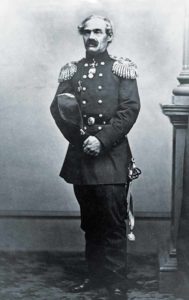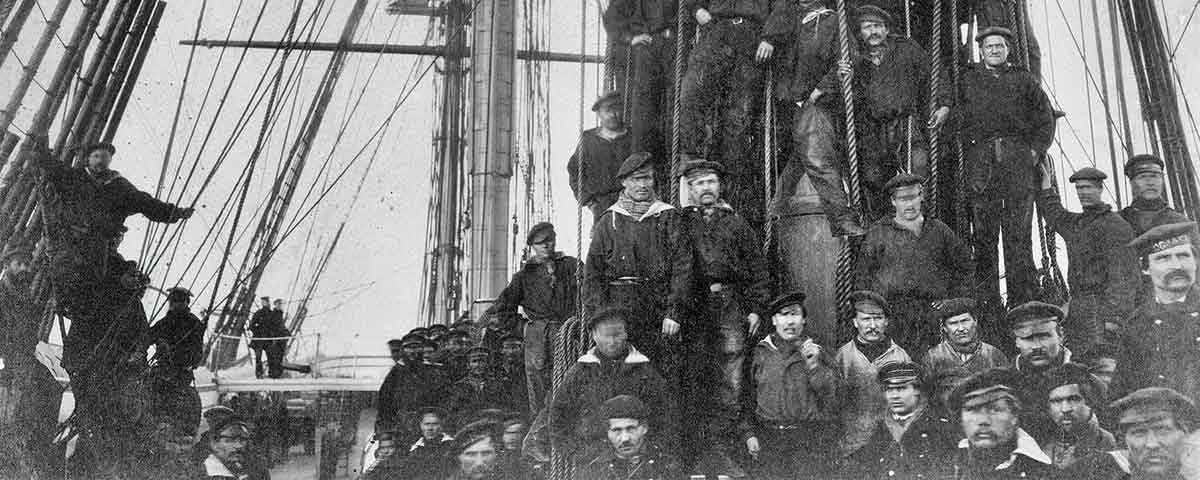Citizens of New York awoke the morning of September 11, 1863, to discover a 33-gun screw frigate anchored off Pier 8 in the city’s harbor. The ship flew what was clearly a foreign ensign—crossed blue stripes against a white field—but one unfamiliar to most New Yorkers. The vessel, it was eventually learned, was Oslyabya, a warship of Russia’s Atlantic Squadron.
No one was probably more surprised than President Abraham Lincoln, who had received no prior notification of the ship’s destination. Nor had the Russian foreign minister or Northern attachés been advised to expect Oslyabya. Events, it turned out, would get a great deal more interesting. The entire Russian fleet was apparently en route—unannounced and uninvited—for a United States visit.
At the time, Poland—an imperial Russian possession—was in revolt, and was enjoying the support of France and England. For the moment, the European powers’ backing was mostly verbal; however, a strong possibility of armed intervention remained. A decade before, Russia had engaged both countries in a costly and embarrassing war in Crimea, and Czar Alexander II was not welcoming a repeat performance.
During the Crimean War, France, Britain, and their allies—the Ottoman Empire and Sardinia—had succeeded in blockading the entire Russian fleet in port—a failure Czar Alexander was determined to avoid should a fresh conflict arise. He therefore instructed his whole fleet to seek safety in the United States. That would not only free his ships from possible blockade, but it would also allow them access to the enemy’s commercial shipping lanes. His government had always been supportive of the Union, whereas England and France constantly threatened to back the rebellious Confederacy. Furthermore, the United States was one of the few countries that hadn’t taken a position adversarial to Russia during the conflict 10 years earlier.
Aware that a dramatic exodus from the Imperial naval base at Kronstadt, near St. Petersburg, would sound an alarm that might spark a military response, Alexander ordered the ships to stagger their departures, and to seek routes that would avoid contact with French and English vessels. Departing one and two ships at a time over a one-month period, the Atlantic Squadron sailed for New York under the command of Rear Admiral Stepan S. Lisovsky, while the Pacific Squadron, under Rear Admiral Andrei Popov, set course for San Francisco.
To evade enemy contact, the fleet charted a little-used route past the Orkney Islands in the North Sea. Despite mostly stormy conditions, the ships weathered the trip well. Once Oslyabya had arrived safely, the other ships gradually followed.

The reception they received was stunning. Local luminaries staged elaborate entertainments for their guests, including a “grand ball” at the Academy of Music. New York City officials, as well as members of Gotham society, visited the foreign vessels. All were impressed with the efficiency of officers and crew, and the cleanliness of the ships. Recorded one journalist: “[A] lady with the most immaculate skirts and kid gloves can move anywhere, on deck or below, without danger of soiling either, so perfectly clean everything about the ship is kept.”
One of the first to visit Oslyabya was the First Lady herself. Mary Todd Lincoln boarded the frigate in the company of Maj. Gen. John A. Dix, commander of the Eastern District, and the wife of Maj. Gen. Nathaniel P. Banks. To the strains of “Yankee Doodle” from the ship’s band, Mrs. Lincoln toasted the czar, creating what the New York Herald called “a hearty response throughout the country.”
Once all the ships of the Atlantic Squadron had arrived, the captains were treated to a trip to Niagara Falls. A party was given during a stopover at West Point, and one of the Russian midshipmen—a fine pianist and budding composer named Nicolai Rimsky-Korsakov—provided entertainment. (Apparently, the assemblage grew too raucous and the musician abruptly ended the concert in disgust.)
Meanwhile, the first ship of the Pacific Squadron to arrive off San Francisco had a somewhat rockier experience—literally. Early on September 26, the captain of the steam corvette Norvick—disoriented by thick fog—plowed his ship into the beach at full speed, whereupon it was broadsided by a huge wave. As the crew scrambled off, a lifeboat capsized and a sailor drowned. The officers and rest of the crew abandoned Norvick and made it safely to shore. One officer was then rowed into San Francisco to report the situation to a San Francisco port official, who sent a revenue cutter to their aid. By this time, however, the ship had broken apart.
Despite the inauspicious arrival, San Franciscans warmly welcomed the foreign seamen, all while speculating wildly about a possible U.S.–Russian alliance. Over the next few weeks, the remainder of the Pacific Squadron sailed and steamed into San Francisco’s harbor. The Russian
sailors further endeared themselves to the populace when a large fire broke out in the city, and they joined the San Francisco Fire Department in fighting the blaze.
In late November, the Atlantic Squadron steamed out of New York Harbor for Federal-occupied Hampton Roads, Va., where Secretary of State William Seward feted the admiral and his officers with a series of state dinners. And on December 19, the president welcomed them to a reception at the White House. The weather, however, was turning cold, and the following week the fleet sailed for the Caribbean to await word of developments in Poland.
In mid-June the fleet reassembled in New York to prepare for the return voyage.
Once he had overcome his initial surprise, Lincoln made it clear he was delighted with the Russian visit. In fact, from a propaganda standpoint, the Russians’ arrival served both nations quite well. Britain and France, assuming an agreement had been reached between the United States and Russia, toned down their pro-Southern rhetoric, another blow to the Confederacy’s hope of foreign intervention on its behalf.
Ron Soodalter, a regular contributor to America’s Civil War, is the author of Hanging Captain Gordon.





